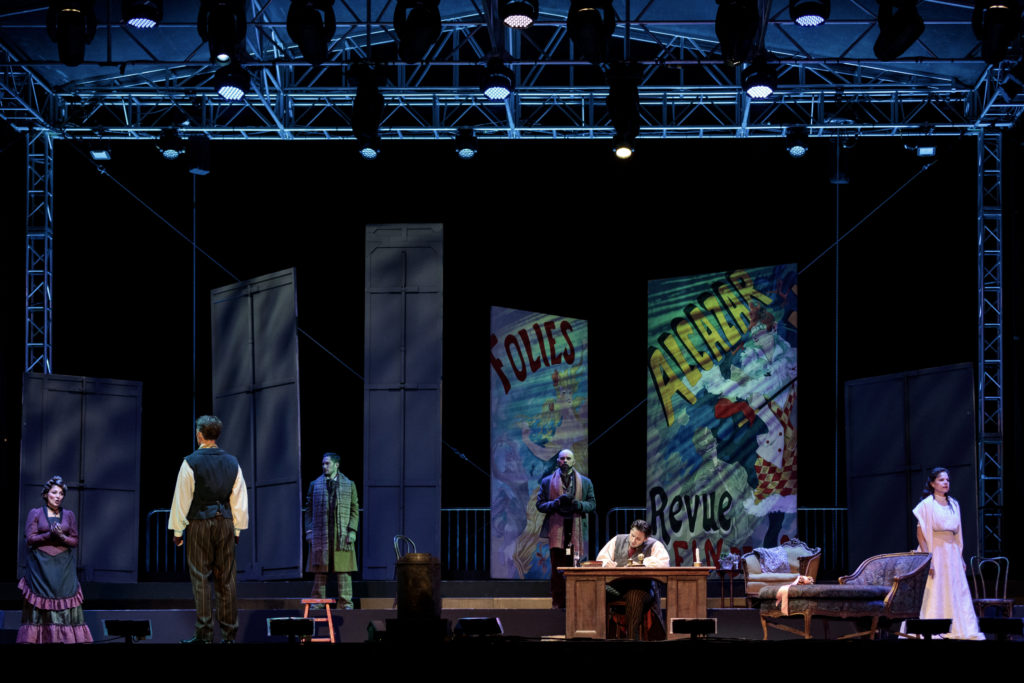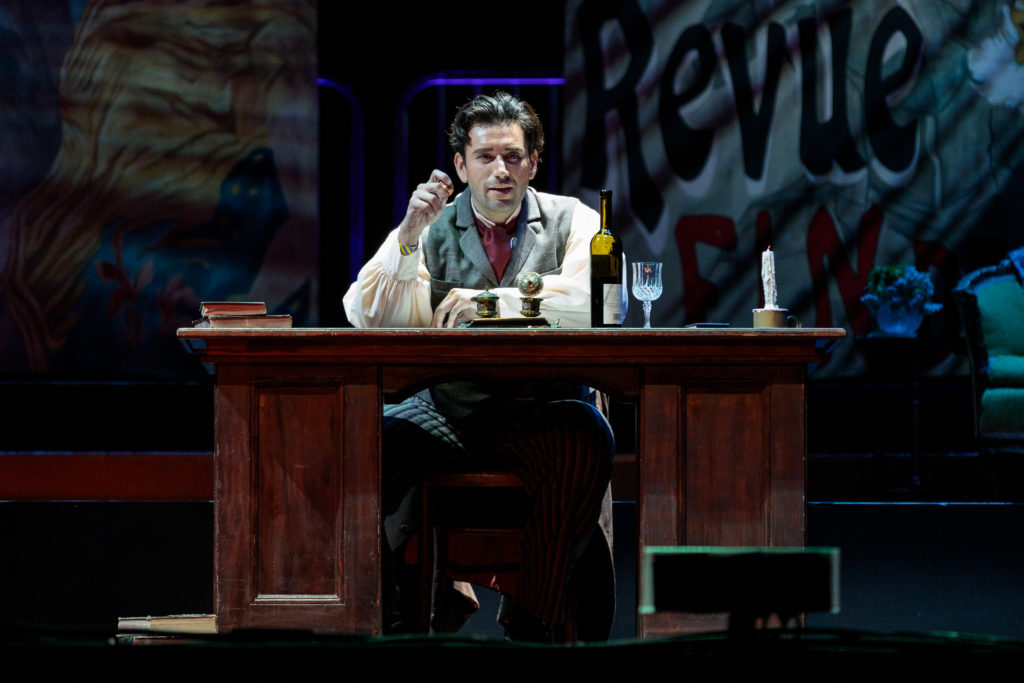San Diego Opera’s Drive-In ‘La bohème’ Brings Live Opera Back with Panache
The most persuasive reason San Diego Opera General Director David Bennett was determined to present his company’s production of Puccini’s La bohème in the Pechanga Arena parking lot: his cast was too spectacular to waste! Opera companies from the vaunted Met in New York City to modest companies in the Midwest have cancelled their 2020-2021 seasons because the Covid pandemic has closed live performance venues. But on Saturday evening (October 24), Bennett boldly opened San Diego Opera’s new season in the sprawling Pachenga Arena lot.

“La bohème” main stage at Pechanga Arena [photo (c.) Karli Cadel]

Joshua Guerrero [photo (c.) Karli Cadel]
To be sure, Guerrero’s “Che gelida manina” radiated tender affection in aptly honeyed, dulcet tones, but in the opera’s third act, when Rodolfo finally confesses to his friend Marcello his despair over Mim’s rapidly failing health, he projected an astonishing level of emotional devastation. Even Mimi’s death scene at the climax of the final act could not match Guerrero’s soul-baring effect in that third-act encounter.
Like other sopranos who sing Mimi and Verdi’s Violetta, Ana María Martínez had to deal with the dilemma of portraying a character in failing health who is required to subdue demanding vocal challenges. Martínez opted to stress the vocal side of that equation, matching Guerrero’s vocal strength and at times fearlessly employing the dramatic edge of her ample soprano to deepen Mimi’s self-understanding. And the pathos of her farewell aria at the close of act three, “Donde lieta usci,” underscored her crucial insight into Mimi.

Alexander Birch Elliott & Andrea Carrol [photo (c.) Karli Cadel]
Bass Colin Ramsey gave a touching account of “Vecchia zimarra,” his final act farewell to the coat he intends to pawn to procure medicine for Mimi. The condensing of Puccini’s score to just under one hour and 40 minutes left rather little for baritone Robert Mellon as Schaunard—Rodolfo’s third garret roommate—and bass baritone Scott Sikon as Musetta’s wealthy sponsor Alcindoro to sing.
To my delight and relief, reducing Puccini’s orchestra to 23 musicians did not compromise the score. Under the direction of Rafael Payare, the San Diego Symphony’s Music Director, these symphony musicians gave a richly hued and well-balanced account of the score from their own tented area adjacent to the main stage. This was Payare’s debut with San Diego Opera, and I hope he will be asked to return regularly. Every San Diego Symphony performance under his baton reveals how well the players respond to his astute direction, and his opera chops leave nothing to be desired. He proved sensitive to the singers’ needs, and his alert pacing kept the drama vibrant.
Given the Covid-driven restrictions on physical contact, director Ketura Stickann moved her singers on the stage with cleverly crafted simulated interactions. Since the closer, small screens focused on the one or two characters who were singing, it was not always easy to know if other characters were still on stage as a part of the scene or if they had exited. Perhaps in the future, the small screens could intersperse big-picture glimpses of the main stage for cars not parked on a direct axis to that stage. The vividly hued period costumes from Opéra de Montréal worked well on the massive outdoor stage, and bits of scenery and furnishings from the back bins of San Diego Opera’s scenic shop proved adequate.
San Diego Opera’s bold solution to presenting live opera to an on-site audience proved far more successful than I imagined possible. I found this production of La bohème as moving as any traditional full-length presentation I have encountered–in some ways even more effective because the opera’s dramatic arc has been so intensely focused. Now the company will decide how much more of its season will be presented in a similar fashion.
This production of Puccini’s La bohème will be repeated at the Pechanga Arena lot on October 27 and 30, as well as November 1, 2020.

Ken Herman, a classically trained pianist and organist, has covered music for the San Diego Union, the Los Angeles Times’ San Diego Edition, and for sandiego.com. He has won numerous awards, including first place for Live Performance and Opera Reviews in the 2017, the 2018, and the 2019 Excellence in Journalism Awards competition held by the San Diego Press Club. A Chicago native, he came to San Diego to pursue a graduate degree and stayed.Read more…

Bravo for such succinct and sensitive reporting. We, the Board, are so very proud of the entire company. What a glorious success.
Warmly,
Sarah B Marsh-Rebelo
Chairwoman San Diego Opera